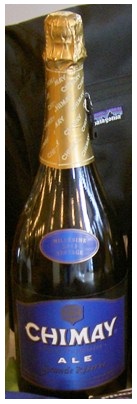Beer Trivia for the Light-Headed Drinker

 “Sometimes Beer Geeks take themselves too seriously. Maybe it’s the left-brain trying to keep control when drinking beer clearly results in social lubrication and a loosened sense-of-self. But a little loosening of the mind is good for you. Research scientists have found that creativity and innovation are greatest during times of relaxation, so little fun facts may lead to success in other areas.
“Sometimes Beer Geeks take themselves too seriously. Maybe it’s the left-brain trying to keep control when drinking beer clearly results in social lubrication and a loosened sense-of-self. But a little loosening of the mind is good for you. Research scientists have found that creativity and innovation are greatest during times of relaxation, so little fun facts may lead to success in other areas.
Although you may consider yourself to be an expert in beer trivia, insert these light-headed little gems into your crown of glory:
Chimay is produced at the Abbaye Notre-Dame de Scourmont, one of the revered Cistercian Trappist breweries in Hainaut, Belgium. It is the most famous of the Trappist beers, but if you are in the Philippines, ordering a Chimay may be accompanied by laughter from your sidekicks. In Filipino, Chimay refers to the housemaid. On a down-and-dirty level, it may even refer to a woman who grants favors of the most indiscreet kind.
Gose and Gueuze may sound similar, but they are different beers from different countries; the former from Germany and the latter from Belgium. Gose is a German sour beer that uses salt to enhance flavor and increase the feel of dryness in the mouth. Some claim Gose leaves you thirsting for more, regardless of the amount consumed. Gueuze is a blend of old and young Belgian Lambic, a sour beer with champagne-like effervescence in the mouth.
The legendary connection between oysters and love may have roots in the taverns of 19th century London. At the time, oysters were common bar food, much like the salted pretzels and peanuts found in American taverns today. It was not unusual for oysters to be paired with “Stout Porter,” a combination that lives on as one with magical gourmet appeal.
Stout, as a style, is one of the most versatile chameleons in the world of beer. Variations seem endless, as brewers create a palette of flavors using chocolate, oatmeal, honey, coffee, smoked malts, lactose, and even oysters, in the mash. This translates to endless appeal for the taste buds and a wide array of sub-categories. Barrel-aging may add an even wider range of complexity.
Beer has religious connections, too. Depictions of Saint Arnold of Flanders often include a straw bee hive. The bee hive did not signify honey mead, as many may assume. Rather, it was used as a filter to clarify the end product.
Have you ever heard of the Köbes of Cologne? Starting in the 9th Century, a hermit named Pelayo reported having a vision in the Libradón Mountains that led to the discovery of a gravesite which held the body of St James the Greater, along with two of his disciples. Devotees of the Catholic religion began making the pilgrimage along one of several routes, to the shrine of St. Jacobus (James) at Santiago de Compostela. Although most devotees journeyed from France, Spain and Italy, many also came from Germany. The journey was made on foot, and those passing through Cologne would stop for a few days where they would serve as beer waiters, to replenish their bodies and earn wages for the balance of their pilgrimage. They identified themselves with a shell on their hats, and were known as the “Köbes of Cologne,” a bastardization of the word Jacobus.
Although Germany is well-known as the source of the Beer Purity Law of 1516 or Reinheitsgebot, it is also famous as the Mecca of mixed beer-based drinks. These were invented for the summer months when Germans sought a thirst quenching beverage that combined beer’s bitter or sour profile with a touch of sweetness. How many of these do you know?
How do you feel about experiencing Hell? In Germany, Hell or Helles refers to a light-colored beer, one that is golden and sessionable; but in Belgium, Duvel refers to the netherworld. Unsuspecting beer novices may incorrectly pronounce the Belgian beer as Du-VELL, not realizing that this beer is from the Dutch-speaking part of Belgium. The correct pronunciation is closer to the English, DOO-vl – like the Devil himself. With its 8.5% alcohol by volume and its light body, it is the ultimate temptation-in-a-glass.
Cheers!
Experience beer through Germann tradition
1 Liter HB "Hofbrauhaus Munchen" Dimpled Glass Beer Stein
Irish Pint glasses with emblems will add a touch of class to your collection:
ARC International Luminarc Irish Beer Label Pub Beer Glass, 16-Ounce, Set of 4
You Should Also Read:
25 Questions - Philly Beer Geek Fun
Beer Trivia for Beer Geeks
Beer Trivia for Beer Enthusiasts - Lightning Round

Related Articles
Editor's Picks Articles
Top Ten Articles
Previous Features
Site Map
Content copyright © 2023 by Carolyn Smagalski. All rights reserved.
This content was written by Carolyn Smagalski. If you wish to use this content in any manner, you need written permission. Contact Carolyn Smagalski for details.



